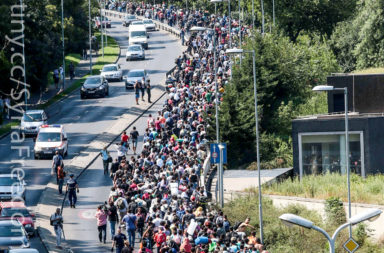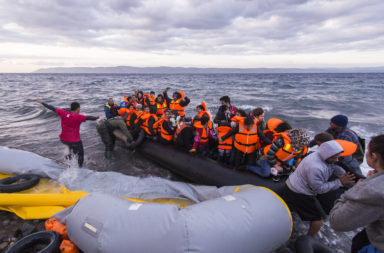Tony Abbott, the former Prime Minister of Australia recently delivered his first public address since he was deposed as leader of the country in mid September of this year. Speaking to a crowd of conservative colleagues at the Margaret Thatcher Centre in London, Abbott outlined his vision to fellow conservatives.
Surely there was no way that he could imagine the horrific events that were to take place in a matter of weeks across the channel. Yet following the recent events in Paris, the topic of his speech, immigration reform only seems all the more relevant today.
Speaking in London, addressing the issue of immigration in Europe, far away from the horror of terrorism or suicide attacks that was yet to follow, Abbott provided a range of lessons that he felt his administration could teach the rest of the world. He felt that conservative governments across Europe faced similar challenges to Australia in the field of immigration and border security, and it was Australia that held the answers. Abbott had stopped the boats of asylum seekers from reaching the shores of his country, and he was in Europe to teach them how they could too.
Asylum seeker policy has been a fiercely contested issue in the island down under for quite some time, but recent events have only further intensified the debate.
Critics of the nation’s treatment of refugees have long since claimed that it is inhumane and unacceptable, pointing to findings from the United Nations and Amnesty International, which reveal that rape, assault and incidences of depression are alarmingly high in Australian run detention centers.
They point to the decision to run detention centers in countries that are not signatories of the United Nations Convention on Refugees, and claim that this indicates a failure on Australia’s part, to uphold the rights embedded with this convention. With a recent finding from the United Nations Human Rights Council condemning Australia’s treatment of refugees, this case is only growing in strength.
Yet advocates for Australia’s current immigration policy respond that without appropriate border security measures, boats will continue to embark on dangerous journeys from surrounding nations, threatening the lives of all onboard. Proponents of this view point to the almost 1100 drowning victims at sea as a result of the change to immigration policy in 2009, and argue that Australia must do everything in its power to stop these preventable deaths.
They point out that under the Abbott administration, there were no new boat arrivals in over 200 days, and that this is essential for squashing the people smuggler trade. And now, there are of course those who point to the Syrian passport that was found on one of the bodies of those who may have perpetrated this most awful of acts, arguing that if we don’t control our borders, those who enter will do the same to us in countries across the globe.
This may or may not be so. It will be up to investigators to determine whether or not this was in fact the case.
Either way, in order to really understand this discussion, we need to rewind a little. It’s important to understand Australian history in order to understand its policies, and in order to understand its history, we have to understand a key event known as the “children overboard”. The children overboard incident has been firmly embedded in the memory of Australians, since 2001. During this time, an event took place in which government officials claimed to have witnessed asylum seekers throwing their children overboard, in order to secure passage to Australia. Indeed, the government released photos as evidence of this occurrence. Unfortunately, or rather fortunately, the photos were later discovered to be false.
However, before this discovery was made, then conservative Prime Minister John Howard (Abbott’s predecessor) campaigned on a platform of border security and arguing that “we will decide who comes to this country and the circumstances in which they come”. Securing a victory in what was deemed an unwinnable election, analysts subsequently claimed that this proved the Australian peoples’ desire for “stronger borders”.
Since this time, successive governments have experimented with less stringent border security policies, only to discover an increase in the number of arrivals by boat to the country. This has only further cemented the view that Australians demand tough border control, with opinion poll after opinion poll showing support for offshore processing of irregular maritime arrivals.
The Abbott government was elected on a platform that aimed to respond to this wave of public opinion. And respond they did.
Introducing the militaristic “Operation Sovereign Borders”, the government placed Major General Andrew Bottrell at the helm of the new border protection measures, in conjunction with his counterpart, former Immigration Minister Scott Morrison.
Morrison and Bottrell quickly became well known throughout the country for their frank, curt briefings where officials would refuse to answer questions about “on water matters”. Morrison was clear that he would provide the information that he wanted the press to have, and would do nothing further to “aide the people smugglers”.
The secrecy was justified in the name of disrupting the people smuggler’s trade. It was necessary to stop the boats and squash this trade, no matter the means used. At least this was the argument the government employed.
Since then, there’s been a change in Prime Minister, a change in immigration minister, a change in boat arrivals and a change in the overall political climate. Nonetheless, the policy remains. So it seems the question for Australia, and indeed the rest of the world is, where to go from here?
The change in ministers appears to mean little for Australia. And so too, the advice that Abbott is now providing to governments across the globe. We’re clearly situated in a brand new world, surrounded by a new world of concerns. So how will governments consider the lessons of a former Australian leader?
Public opinion seemed far from supportive of Abbott as he embarked on the first of his speaking tours, and it seemed that few were willing to take on his recommendations at the time of their giving. But after the events of Paris, with the world searching for answers, who knows where we will look to next for answers.




